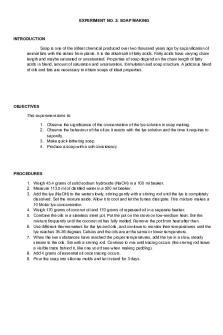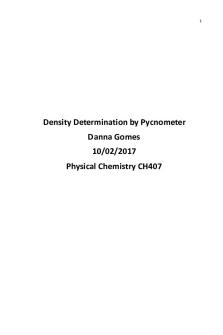A&P 1 Laboratory Report 9 2021 PDF

| Title | A&P 1 Laboratory Report 9 2021 |
|---|---|
| Course | Anatomy and Physiology I (with lab) |
| Institution | Massachusetts College of Pharmacy and Health Sciences |
| Pages | 5 |
| File Size | 75.4 KB |
| File Type | |
| Total Downloads | 105 |
| Total Views | 176 |
Summary
Roberto Rodriguez, DHSc, MS, MD
Lab 9: skeletal system, Vertebral Column / Thoracic Cage
Pectoral Girdle and Upper Limb...
Description
A&P I – Laboratory Report 9
2021
Lab Assessment 15 Part A 1. The vertebral column encloses and protects the _spinal cord_________________ 2. The vertebral column extends from the skull to the ___inferior Ep of the coccyx_________ 3. The seventh cervical vertebra is called the __vertebra prominens____________and has an obvious spinous process surface feature that can be palpated 4. The ______Body________________of the vertebrae support the weight of the head and trunk 5. The _____carElaginous intervertebral discs________separate adjacent vertebrae, and they soNen the forces created by walking 6. The intervertebral foramina provide passageways for _spinal nerves______________ 7. Transverse foramina of _____cervical________vertebrae serve as passageways for blood vessels leading to the brain 8. The first vertebra is also called the __atlas_________________ 9. When the head is moved from side to side, the first vertebra pivots around the _____dens__(odontoid process)_________of the second vertebra 10. The _____lumbar__________vertebra have the largest and strongest bodies 11. The number of vertebrae that fuse in an adult to form the sacrum is____5_________ Part B Based on your observaEons , compare typical cervical, thoracic, and lumbar vertebrae in relaEon to the characterisEcs indicated in the table.
Vertebra
Number
Size
Body
Spinous Process
Transverse Foramina
Cervical
7
Smallest
Smallest
C2 through C6 are forked (slender)
Present, 2 transverse
Thoracic
12
intermediate
Intermediate
Long and fairly thick (most project inferiorly)
Absent
Lumbar
5
Largest
Largest
Short and blunt absent (project posteriorly rather than inferiorly)
IdenEfy the bone features in figures 15.7 and 15.8 15.7 1. costal facets 2. Spinous processes 3. Transverse processes 4. Median sacral crest 5. coccyx 6. Atlas 7.Axis 8. Thoracic vertebra 9. Intervertebral foramen 10. Intervertebral disc 11. sacral promontory
15.8 1. Spinous process 2. Atlas 3. Axis
4. Transverse process 5. Intervertebral disc 6. Body
Part C 1. The manubrium , body, and xiphoid process form a bone called the ___sternum___________ 2. The last two pairs of ribs that have no carElaginous a]achments to the sternum are someEmes called____floaEng ribs____________ribs 3. There are____7___________ pairs of true ribs 4. Costal carElages are composed of ____hyaline__________Essue 5. The manubrium arEculates with the __clavicle_______________on its superior border 6. List three general funcEons of the thoracic cage a. Breathing b. Supports the pectoral girdle and upper limbs c. Protects the thoracic and upper abdominal organs 7. The sternal angle indicates the locaEon of the ____second____________pair of ribs Part D IdenEfy the bones and features indicated in figure 15.9
15.9 1. Jugular notch 2. sternum 3. floaEng rib 4. clavicular notch 5. sternal angle 6. true rib 7. costal carElage of true rib 8. costal carElage of false rib
Lab Assessment 16
Part A 1. The pectoral girdle is an incomplete ring because it is open in the back between the __the scapula____ 2. The medial end of a clavicle arEculates with the _manubrium__________of the sternum 3. The lateral end of a clavicle arEculates with the __acromian _______ process of the scapula 4. The ___clavical________is a bone that serves as a brace between the sternum and the scapula 5. The_______spine___divides the scapula into unequal porEons 6. The lateral Ep of the shoulder is the __acromian process_________of the scapula 7. Near the lateral end of the scapula, the __coracoid __________process of the scapula curves anteriorly and inferiorly from the clavicle 8. The glenoid cavity of the scapula arEculates with the ____head______of the humerus Part B Label the structures indicated in figure 16.6 1.Acromion 2. coracoid process 3. Spine 4. infraspinous fossa 5. Medial border 6. Inferior angle 7. Glenoid cavity 8. Lateral border
Part C Match the bones in column A with the bones and features in column B ___A. carpals__1. Capitate __B. humerus ___2. Coronoid fossa __B. humerus___3. Deltoid tuberosity _B. humerus____4. Greater tubercle __C. metacarpals___5. Five palmar bones __D. phalanges___6. Fourteen bones in digits
__B. humerus___7. Intertubercular sulcus ___A. carpals__8. Lunate __B. humerus___9. Olecranon fossa __E. radius___10. Radial tuberosity ___A. carpals__11. Trapezium ___F. ulna__12. Trochlear notch Part D IdenEfy the bones and features indicated in the radiographs of figures 16.7 , 16.8 and 16.9 Figure 16.7 1. Humerus 2. olecranon process 3. head of radius 4. radius 5. ulna Figure 16.8 1. acromion 2. head of humerus 3. clavicle 4. scapula 5. Rib 6. humerus
Figure 16.9 1. Phalanges 2. Metacarpals 3.Carpals 4. distal phalanx 5. proximal phalanx...
Similar Free PDFs

A&P 1 Laboratory Report 9 2021
- 5 Pages

Laboratory Report 1 SKO3023
- 30 Pages

Lab 1 - Laboratory Report
- 10 Pages

Laboratory+report+1-4
- 11 Pages

Mod 9 Laboratory 1
- 5 Pages

Laboratory 9
- 3 Pages

A&PI Laboratory Report 13 2021
- 2 Pages

A&P I Laboratory Report 2 2021
- 2 Pages

A&P I Laboratory Report 4 2021
- 2 Pages

Laboratory 11 - Lab Report
- 3 Pages

Laboratory report - aspirin
- 8 Pages

Laboratory Report Rubric
- 2 Pages
Popular Institutions
- Tinajero National High School - Annex
- Politeknik Caltex Riau
- Yokohama City University
- SGT University
- University of Al-Qadisiyah
- Divine Word College of Vigan
- Techniek College Rotterdam
- Universidade de Santiago
- Universiti Teknologi MARA Cawangan Johor Kampus Pasir Gudang
- Poltekkes Kemenkes Yogyakarta
- Baguio City National High School
- Colegio san marcos
- preparatoria uno
- Centro de Bachillerato Tecnológico Industrial y de Servicios No. 107
- Dalian Maritime University
- Quang Trung Secondary School
- Colegio Tecnológico en Informática
- Corporación Regional de Educación Superior
- Grupo CEDVA
- Dar Al Uloom University
- Centro de Estudios Preuniversitarios de la Universidad Nacional de Ingeniería
- 上智大学
- Aakash International School, Nuna Majara
- San Felipe Neri Catholic School
- Kang Chiao International School - New Taipei City
- Misamis Occidental National High School
- Institución Educativa Escuela Normal Juan Ladrilleros
- Kolehiyo ng Pantukan
- Batanes State College
- Instituto Continental
- Sekolah Menengah Kejuruan Kesehatan Kaltara (Tarakan)
- Colegio de La Inmaculada Concepcion - Cebu



